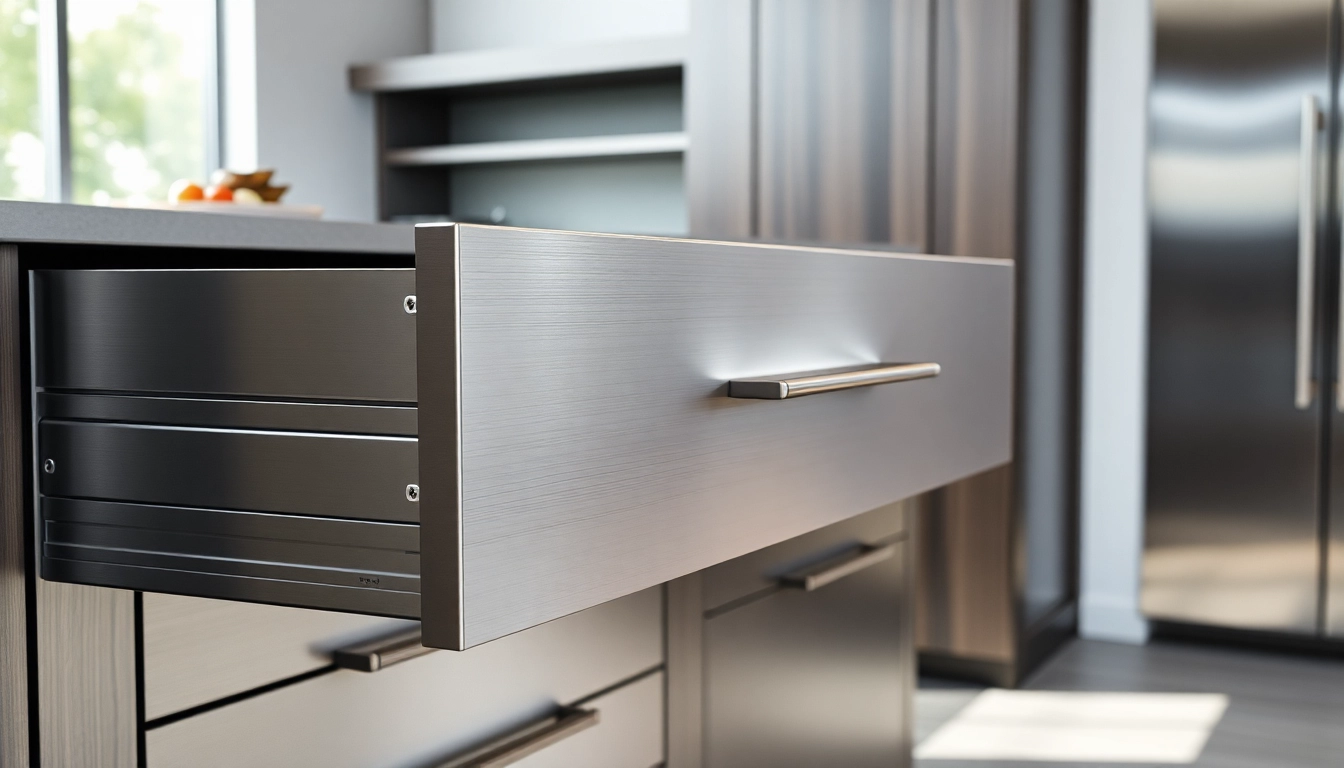Introduction to Metal Drawer Systems
In a world where functionality meets aesthetics, Metal Drawer Systems have emerged as a popular solution for both home and commercial applications. These systems not only provide robust storage options but also enhance interior designs with their sleek finishes and innovative functionality. As we delve deeper into the realm of metal drawer systems, we will explore what they are, their common applications, and the advantages they hold over traditional wooden alternatives.
What Is a Metal Drawer System?
A metal drawer system is essentially a framework that supports drawer components made primarily of metal. This system includes the drawer box, slides, and hardware that facilitate smooth opening and closing motions. These components are engineered to optimize storage efficiency and enhance the overall user experience. While the traditional wooden drawer system has long been a staple in cabinets, the evolution to metal drawer systems signifies a shift towards durability, modern design, and enhanced functionality.
Common Applications for Metal Drawer Systems
Metal drawer systems find applications in various environments, including:
- Residential Use: In kitchens, bathrooms, and closets, where storage space is essential.
- Office Space: In filing cabinets and desks where organization and accessibility are crucial.
- Industrial Settings: For tool storage units and work benches that require heavy-duty solutions to manage tools and equipment.
- Retail Displays: In showcasing merchandise while providing the functionality of storage.
Advantages of Using Metal Over Wood
Using a metal drawer system presents several advantages:
- Durability: Metal systems are less prone to warping and damage compared to wood, making them suitable for high-use environments.
- Load Capacity: They can generally handle more weight, especially in commercial settings where heavy items are stored.
- Design Flexibility: Metal can be molded into various shapes and finishes, allowing for modern and sleek designs.
- Maintenance: Metal is typically easier to clean and maintain, resisting stains and odors.
Key Features of Metal Drawer Systems
Sliding Mechanisms: Soft Close vs. Self-Close
Metal drawer systems employ different sliding mechanisms that affect their operation. The two most common types are:
- Soft Close: This mechanism allows drawers to close gently and quietly, preventing slamming and prolonging the lifespan of both the drawer and slides.
- Self-Close: Drawers equipped with self-close mechanisms automatically pull themselves into a closed position after being pushed, offering convenience for high-traffic areas.
Understanding these mechanisms is crucial for choosing the right metal drawer system based on your usage needs and noise considerations.
Material Durability and Load Capacity
One of the distinguishing factors of metal drawer systems is their robust construction. Made from materials like steel or aluminum, they often feature protective coatings to resist rust and corrosion, making them an ideal choice for environments exposed to moisture or fluctuating temperatures. Additionally, typical load capacities range from 75 pounds to over 300 pounds, depending on the specific design and materials used. This ability to support heavy loads is particularly beneficial in commercial and industrial applications.
Design Variations: Style and Aesthetics
The aesthetics of metal drawer systems have evolved considerably. Today, they come in a variety of finishes including matte, brushed, and polished options. Design customization is also possible through various colors and styles that can align with contemporary or traditional decor themes. Whether integrated into kitchen cabinetry or stand-alone office furniture, the versatility of designs allows for seamless incorporation into any space.
Choosing the Right Metal Drawer System
Assessing Your Needs: Home or Commercial Use
When selecting a metal drawer system, it’s essential to assess your specific requirements. For residential applications, consider factors like the size of the drawers needed for kitchen utensils versus clothing storage. In commercial settings, the demands on load capacity and durability may necessitate systems specifically designed for heavy use. Understanding these differences will guide you in making the right selection.
Size and Configuration Considerations
The dimensions and configuration of your drawers are critical for maximizing efficiency:
- Depth and Width: Ensure the drawer size is compatible with your cabinetry or shelving unit while effectively utilizing available space.
- Configurations: Consider whether you need multiple drawers or a single, larger drawer and how each setup will cater to your specific storage needs.
A well-planned drawer configuration can significantly enhance the functionality of any space.
Budgeting for Quality Metal Drawer Systems
Budgeting for metal drawer systems involves evaluating the quality versus the price. While cheaper options may be tempting, investing in high-quality systems can yield long-term benefits, such as durability and reduced maintenance. Researching and comparing various suppliers will provide insight into the best prices for the quality you desire. Remember that you often get what you pay for in terms of performance and aesthetics.
Installation and Maintenance Tips
Step-by-Step Installation Guide
Installing a metal drawer system can be straightforward if you follow a structured approach. Here’s a basic step-by-step guide:
- Gather Your Tools: You’ll need a drill, screwdriver, level, and measuring tape.
- Measure and Mark: Determine where the drawer slides will be positioned on the sides of the cabinet, marking the spots with a pencil.
- Install the Slides: Using the drill, attach the side slides within the cabinet, ensuring they are level and secure.
- Assemble the Drawer: Attach the metal drawer box together according to the manufacturer’s instructions, and then install the slides onto the drawer.
- Fit the Drawer: Carefully slide the assembled drawer into the slides, ensuring it moves freely.
This guide simplifies what can sometimes be a complex process, but always refer to the manufacturer’s instructions for specifics.
Routine Maintenance for Longevity
To ensure your metal drawer system remains in optimal condition:
- Regular Cleaning: Wipe down the drawer surfaces regularly with a damp cloth to remove dust and debris.
- Inspect Mechanisms: Periodically check the slides for wear and ensure the soft-close or self-close mechanisms are functioning properly.
- Lubricate Moving Parts: A silicone-based lubricant can prevent sticking and enhance the smooth operation of drawers.
Common Issues and Troubleshooting
Even the best systems can encounter issues. Addressing common problems like a sticking drawer or misaligned slides is crucial:
- Sticking Drawers: Check for obstructions within the drawer and verify that slides are properly aligned.
- Misaligned Drawers: Adjust the slide positions or repairing them might be required for proper function.
- Noisy Operation: A quick lubrication can often resolve noise issues stemming from the slides.
Conclusion: The Future of Metal Drawer Systems
Innovative Trends in Drawer Design
The future of metal drawer systems is characterized by technology and design innovations. Advancements such as integrated lighting, automated opening mechanisms, and high-end finishes are becoming more prevalent, catering to contemporary design needs and enhancing functionality.
Environmental Considerations and Sustainability
As awareness of environmental issues grows, manufacturers are increasingly focusing on sustainability. Many companies are adopting practices that ensure recyclable materials are used in production and energy-efficient processes are followed for manufacturing metal drawer systems.
Where to Buy: Recommended Suppliers
When looking to purchase metal drawer systems, consider reputable suppliers known for quality and service. Websites like CabinetParts.com and Richelieu provide extensive selections, while manufacturers like Blum and Häfele offer unique product lines that focus on innovative designs and functionality.




